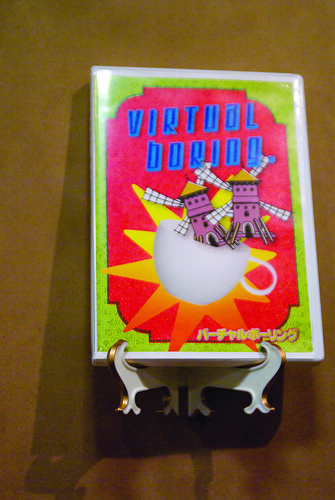
A mustached, female villain, twin heroines and a floating virtual teacup break the boundaries of traditional art and create a bridge between video game and film media in J. Makary’s newest creative endeavor, “Virtual Boring.”
Makary wanted to create a video game that frustrated her viewers and she hopes she did just that with “Virtual Boring.” In the beginning, her concept of creating a video game was complex.
“Initially, this project was to be a functional video game that a viewer could play,” said Makary, who is a film artist, designer and interpretive dancer. “The teacup character in the resulting video project was going to be the player, and there would have been the live video of my three actors, as well as Flash buttons and game activities that were designed to frustrate the viewer.”
Unfortunately, Makary lost her Flash programmer midway through her project, but nevertheless, she pursued her initial goal, labeling her final product as more of a “skills- building project.”
“I dreamed up a way to repurpose the video footage, using it more as a found object or raw material, than as footage shot with a specific aim in mind,” she said.
Using the materials she had, Makary created a project that not only frustrates gamers with the concept of a non-interactive video game, but pushed the boundaries of traditional media art.
“[This project reveals] my unconventional exploration of humor, frequently through absurd imagery and the use of Foley effects that may or may not match the action in a realistic manner,” Makary said.
Located in the International House of Philadelphia, the “Virtual Boring” exhibit is only a small part of a larger concept. The IHouse, which serves as a residence hall for international students from Drexel University, University of Pennsylvania and Temple, works with InLiquid, a nonprofit organization that organizes art exhibitions within its Ibrahim Theater lobby.
The two organizations showcase new and experimental artists from the Philadelphia region in an attempt to create more interaction between the community and diverse forms of art.
Makary is one of the showcased artists for this month.
“Virtual Boring” is advertised by InLiquid and the IHouse as a multimedia project that is part film, part video game. The “Virtual Boring” exhibit includes the presentation of a looped video on a television screen set up in the corner of the IHouse lobby.
The project is surrounded by ottomans for viewers to sit on while watching the four-minute, 11- second long presentation.
A second television screen is provided with a scratchy visual of a pair of hands playing with a video game controller. This second television set is topped with a bouquet of funeral flowers. Makary makes her point: this video game she has created provides no human interaction.
“Virtual Boring” begins with a welcome screen for players just like any other video game. Because the game doesn’t require controllers, the viewer is forced to wait for the game to begin on its own. The game begins with a story based on a pair of twins who attempt to defeat the mustached, female villain. Throughout the narrative, a virtual teacup floats behind the characters through the scenes.
Makary took sounds normally associated with certain actions and warped them in her study. Throughout “Virtual Boring,” sound effects from older video games frame the background but conventional action sounds are altered.
For example, as the villain in the video game laughs, the viewer hears a small whistle looped over and over.
“I like to experiment with sound substitutions because they force a very light form of cognitive dissonance on the viewer,” Makary said.
She also experiments with the antiquated picture in her piece, as each scene commences with “jerky” motions, much like what could be seen in a 20th century film. This concept adds to the absurdity of her work and combines old and new forms of media arts.
The “reel film” effect, altered sound effects, as well as the bizarre narrative, characters, and visuals within the game create a discomfort toward viewers – a concept Makary explores throughout other media projects and interpretive dances.
As with most of her media art and interpretive dances, Makary experiments with visual elements to convey the humor and absurdity within life and nature. She credits the help of David S. Kessler, Johnny Woods and performers Anna Matijasic, Kate O’ Halloran and Lydia Adler Okrent, saying each of them “were so much fun to work with.”
With their help and the Makary’s creativity, “Virtual Boring” demonstrates the humor of inevitability that exists in video games, as well as in life. She doesn’t promote a negative message concerning video games. Instead, she pushes her audience with her unconventional artistic concepts.
Makary’s “Virtual Boring” exhibit runs through May 1 at the International House of Philadelphia, located at 3701 Chestnut St. and can be viewed during gallery hours: Monday through Friday between 10 a.m. and 5p.m.
Nicole Welk can be reached at nicole.welk@temple.edu.


Virtual boring seems to be something you have to see in person to full understand it, but sounds an interesting project – just a shame to have lost the flash programmer mid-way through!!
I was recommended this website through my cousin. I’m now not positive whether or not this submit is written by way of him as nobody else realize such designated approximately my problem. You’re amazing! Thanks!